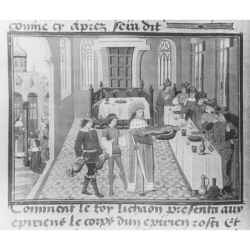Topic: 2. Sacrifice and religion: Comparisons, Antiquarians, Anthropology (16th-18th Century)
Religious sacrifices across various cultures and contexts sparked widespread interest in Early Modern Europe. As Christianity expanded into regions inhabited by "infidels" and "pagans", Europeans encountered a diverse array of sacrificial customs, ranging from the Sati rituals in India to the Aztec sacrifices in the Americas. This cross-cultural exposure captivated a wide audience, including theologians, philosophers, political thinkers, antiquarians, orientalists, missionaries, poets, artists, and even the general public. These encounters broadened the European understanding of sacrifice and led to a critical reassessment of classical and biblical sacrificial rites. This section includes:
- Sources: A selection of early modern printed materials, which include descriptions of the Americas, Asia, and Africa, alongside antiquarian and philological studies on religious sacrifice in classical antiquity and beyond. It also presents early modern works of ethnological observations and the first attempts to compare different sacrificial practices in various traditions and contexts, laying the groundwork for disciplines like the history of religions and anthropology.
- Iconographic Representations: A rich collection of images from the 16th to 18th centuries, illustrating a range of sacrificial rituals and practices as seen in different cultural and geographical contexts.
- Related Bibliography: An extensive bibliography spanning scholarly works from the 19th to 21st centuries, providing contemporary analyses and interpretations of these early studies and observations.
A Spanish Source on Mid-ninth-century Mar Saba and a neglected Sabaite Martyr.
in: The Sabaite Heritage in the Orthodox Church from the Fifth Century to the Present, pp. 63 - 72
Leuven (Belgium): Peeters, 2001.
A vindication of the right reverend the Ld. Bishop of Norwich: from the undeserved reflections of Mr. John Johnson, in his book The unbloody sacrifice and altar unvailed and supported
London: John Morphew, 1714.
Origines Hebrææ: the antiquities of the Hebrew republick: In four books. I. The origin of the Hebrews; their civil government; the constitution of the sanhedrim; forms of trial in courts of justice, &c. II. The ecclesiastical government; the consecration of the high-priests, priests, and levites. The revenue of the priesthood the sects among the Hebrews, pharisees, sadducees, essenes, &c. III. Places of worship. The use of high-places; a survey of the tabernacle, and the proseucha's of the Hebrews. A description of the first temple from the scriptures, and of the second from the rabbinical writings. The sacred utensils. The institution of synagogues, &c. IV. The religion of the hebrews. Their sacrifices; and their libations. The burning of the red heifer, and ceremonies of purification. Their sacraments, publick fasts and festivals, &c. Design'd as an explanation of every branch of the levitical law, and of all the ceremonies and usages of the Hebrews, both civil and sacred
London: Sam Illidge ; John Hooke, 1724.
Lycaon serves human flesh to Jupiter (1467)
from: Historia Troyana
Brussels, Bibliothèque royale de Belgique
Debreasting, Disarming, Beheading: Some Sacrificial Practices of the Scyths and Amazons
in: Death, War, and Sacrifice: Studies in Ideology and Practice, pp. 198-208
Chicago: University of Chicago Press, 1991.
The Druids and Human Sacrifice
in: Death, War, and Sacrifice: Studies in Ideology and Practice, pp. 176-187
Chicago: University of Chicago Press, 1991.
A Sum or a brief collection of holy signes, sacrifices and sacraments, even since the beginning of the worlde: and the true originall of the sacrifice of the masse
London: Rouland Hall, 1563.
Itinerario, Voyage ofte schipvaert, van Jan Huygen van Linschoten naer Oost ofte Portugaels Indien
Amsterdam: Cornelis Claesz. , 1596.
Sanctuary, Sovereignty, Sacrifice : Canadian Sanctuary Incidents, Power, and Law
Vancouver: University of British Columbia Press, 2005.
Spartizione e comunità nei banchetti greci
in: Sacrificio e società nel mondo antico, pp. 211-229
Roma - Bari: Laterza , 1988.
Sacrifice and Islamic Identity
in: Sacrifice in Modernity: Community, Ritual, Identity, pp. 221-229
Leiden: Brill, 2017.
Sacrifice and Islamic Identity
in: Sacrifice in Modernity : Community, Ritual, Identity : from Nationalism and Nonviolence to Health Care and Harry Potter, pp. 221-229
Leiden: Brill, 2017.
The Highest Altar : unveiling the Mystery of Human Sacrifice
New York: Penguin Books, 1990.
Figurarum, pro Missionum, Historiarum, Caeremoniarum, Victimarum, & Sacrificiorum, Ex Testamento vetere, Ad Christum Dei Filium, & Ecclesiam eius pertinentium Synaoroisis
Franc: Haered. Ch. Egen., 1560.
‘Dead Women Tell No Tales:’ Issues of Female Subjectivity, Subaltern Agency and Tradition in Colonial and Post-colonial Writings on Widow Immolation in India
in: History Workshop Journal, v. (1993), issue : pp.208-227.
Philosophia antigua poetica del doctor Alonso Lopez Pinciano, medico cesareo. Dirigida al Conde Iohanes Keuehilerde Aichelberg, Conde de Frankemburg, Baron absoluto de Landtscron y de Wernsperg, Señor de Osteruiz y Carlsperg, Cavallerizo Mayor perpetuo y hereditario del Archiducado de Carinthia, Cavallero de la orden del Tuson del Rey nuestro señor, y del Consejo y de la Camara del Emperador, y su Embaxador en las Españas
Madrid: Thomas Iunti, 1596.
Les rites de chasse chez les peuples sibériens
Paris: Gallimard, 1953.

